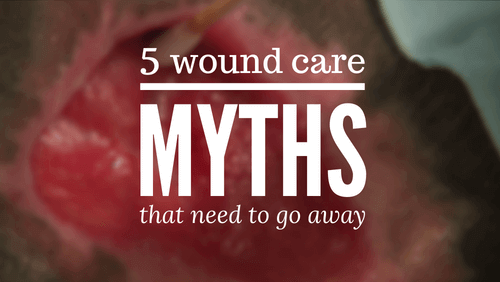The field of wound care has come a long way. And with over 25,000 WCEI alumni across the country sharing their skills and knowledge, we’re thrilled to see many outdated notions and practices go by the wayside. Unfortunately, there are still some wound care myths out there that just refuse to die. Here are five of the most frequent incorrect statements we still hear about out in the field.
Myth #1: Wet-to-dry dressings are cheaper to use.
Not only is wet-to-dry substandard care (as we discuss in Wet-to-Dry Dressings: Why Not?), it’s not even cost-effective.
Here’s the math: The daily cost of care for a foam dressing is only $3.55. The daily cost of wet-to-dry is $12.26. Why the big difference? Wet-to-dry dressings require frequent changes, and each dressing change causes a drop in wound temperature. In order for a wound to heal, it should be close to normal body temperature. So if there is a 2⁰ C drop in temperature, this will slow or stop healing, and it can take up to four hours for that wound to warm up and get back to get back to normal healing temperature. As we always say, “When the temperature drops, the healing stops.”
Out of all the different dressings out there, foam keeps the wound bed the warmest. And foam dressings can remain in place from 3 to 7 days, decreasing costs, labor and drops in temperature. As always, with any dressing application, follow the manufacturer’s instructions on proper usage.
Myth #2: Bleeding in a chronic wound is a sign of healing.
“Oh, it’s bleeding! That’s good!”
No, that’s not normal or acceptable. Sanguineous (bloody) exudate serves as a clue to bedside clinicians that you need to go in and investigate what is causing the bleeding. Start by looking for:
- malignancy or trauma on the site
- high bioburden?
- a dressing that sticks to the wound and causes bleeding upon removal
By putting on our detective hats and looking at the clues the wound is giving us, we can identify issues sooner rather than later.
Myth #3: Erythema is a sure sign of wound infection.
Erythema in the periwound is one of the classic signs of local infection, but it’s not enough to label it as infected. You need to see at least three signs and symptoms. Here are some additional signs and symptoms to consider:
- Foul odor
- Increasing pain in the wound
- Heat in the periwound
- Purulent drainage
- Edema
If you see at least three of these signs, it means you have local infection and need to immediately treat the wound topically, before it moves into a systemic infection.
Myth #4: Oral or IV antibiotics are indicated for all infected wounds.
Administer oral or IV antibiotics only if infection extends beyond the wound margin, indicating a systemic infection. In other words, you need to see signs and symptoms such as fever, an elevated white blood cell count, or red streaks emanating from the wound.
Oral antibiotics are simply not the most effective treatment for local infections. Many chronic wounds have impaired blood flow, which can compromise the delivery of oral antibiotics to that wound. Meanwhile, the unnecessary use of antibiotics leads to the development of antibiotic-resistant strains of bacteria.
So make sure you have first identified if this is a local or systematic infection. If systematic, then you should treat with oral/IV antibiotics.
Myth #5: Clinicians are not responsible if a physician orders inappropriate treatment.
 “I did it because the doctor ordered it.”
“I did it because the doctor ordered it.”
We hear this excuse all the time! Would you administer improper heart medication to a patient if you knew it was wrong? You have to think of wound care the same way. It’s our responsibility to uphold the standards of care. If physicians are unaware of the guidelines and policies, we need to educate them.
Saying that the doctor wrote it and you merely followed orders is not going to protect you legally, and it’s certainly not in the best interest of your patient. Always practice the current standard of care – no excuses!
What myths do you battle?
While these are some of the most common myths in wound care, we know there are more. What are some of the common misconceptions within your practice, and how to you deal with them? Have you been in a situation where you had to help educate physicians or colleagues? Please tell us about your stories below.
What do you think?


